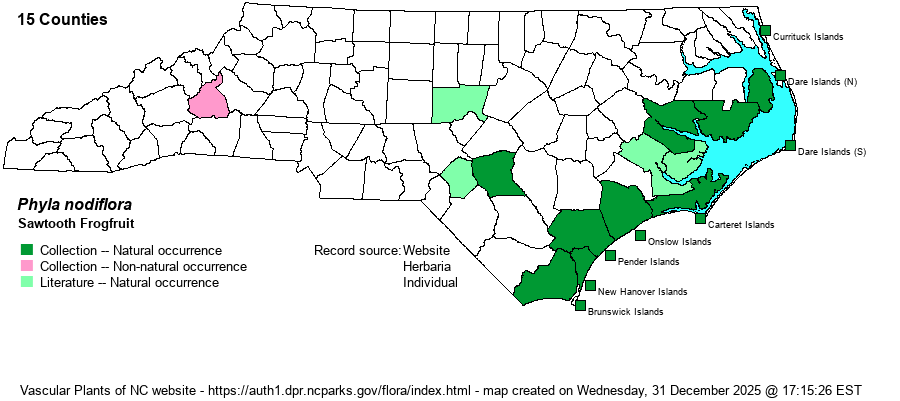| Author | (L.) Greene | |
| Distribution | Along and near the entire coast, very rarely farther inland in the southern Coastal Plain. Taxon editors have not found the specimen voucher for Cumberland County (RAB dot), but there is a 2025 photo on iNaturalist of a population in nearby Hoke County. There is a vetted photo from Chatham County on iNaturalist. A specimen from McDowell County is correctly identified but non-native here: "low sandy place at Old Fort, N.C.", 8 July 1935, H. Cox s.n. (FUGR).
This is a widespread Southern species, ranging from extreme southeastern VA south to the Gulf Coast, and ranging northward in the West to OR. In the South Atlantic states, it is essentially coastal except in FL.
| |
| Abundance | Fairly common to locally common to very common, often in dense stands. The NCNHP's State Rank of S3 is woefully conservative, and this is an S4 species in the state. | |
| Habitat | This is a rather weedy native species in NC, growing along sandy roadsides, lawns, clearings, dunes, and other similar places. It can grow in damp sands in more natural places, in interdune swales and on shell middens. As it is a low-growing species, it must survive in places with little other competition. | |
| Phenology | Blooms from late May to frost, and fruits shortly after flowering. | |
| Identification | This is a mostly decumbent, creeping plant, rooting at nodes. It has two or more leaves at a node, and these are rather short and obovate to spatulate, about 1-inch long and 3/4-inch wide, with serrations toward the apex. The flower clusters are on slender raised stalks, often 2-3 inches tall, and are in a dense rounded ball, with tiny white flowers (about 1/5-inch across at most) as in P. lanceolata. From above, the flowers are arranged in a whorl, quite conspicuous. As it grows along the ground, it typically occurs in dense patches, many yards across. The other species has much longer and more elliptical leaves, about 4 times as long as wide, and it is more erect as well. Thankfully for this species, it grows low enough that it can often escape mowers of coastal roadsides, as in some such places it carpets the ground. | |
| Taxonomic Comments | These two species were formerly placed in the genus Lippia.
| |
| Other Common Name(s) | Common Frogfruit, Creeping Frogfruit, Turkey-tangle Frogfruit, Texas Frogfruit, Capeweed. This species simply does not have a common name that has stuck with numerous websites and references. Note that the group common name has often been call "Fogfruit" instead of "Frogfruit". It is not clear which is correct, or best to use. | |
| State Rank | S3 [S4] | |
| Global Rank | G5 | |
| State Status | | |
| US Status | | |
| USACE-agcp | FAC link |
| USACE-emp | FACW link |

